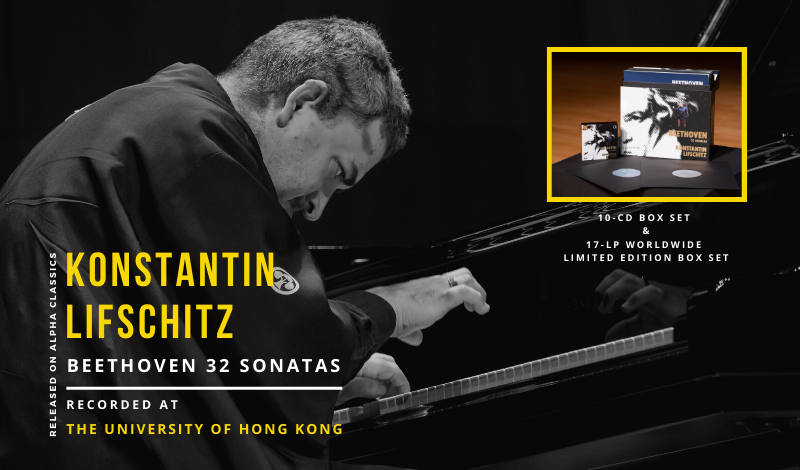‘Beethoven 32 Sonatas’ 10-CD Box Set and 17-LP Box Set

【列夫席茲:貝多芬32奏鳴曲全集】10CD及全球限量珍藏版500套17片黑膠盒裝
Konstantin Lifschitz’s ‘Beethoven 32 Sonatas’ 10-CD and 500 Worldwide Limited 17-LP Boxsets
港大的錄音,琴音充滿活力,有臨場感。—— 《HIFI音響》雜誌音樂版主編劉志剛
錄音效果自然真實,充分呈現音樂廳現場氣氛,琴音晶瑩鏗鏘,比例適中,沒有刻意的凸顯低音鍵音響效果,保留了演奏者的音樂平衡性。—— 《音響論壇》雜誌總編輯劉漢盛
《經濟學人》(2020/11/21 期)談到「命運使貝多芬的音樂更具感染力,並非源於他的奮力掙扎,而是他能撫慰人心」。當我們各自面對疫情下的困境,也許可以從他的音樂中找到慰藉及勇氣。
貝多芬生於1770年12月,距今整整250年。為這誕辰紀念,Alpha Classics繼早前發行的【列夫席茲32首貝多芬鋼琴奏鳴曲】10-CD 盒裝後,現推出限量珍藏版17片黑膠盒裝。這套在港大李兆基會議中心大會堂的現場錄音,是全球首套180克全新錄製貝多芬鋼琴奏鳴曲全集的黑膠盒裝。12吋黑膠的金屬直刻母盤 (DMM) 由德國著名公司老虎魚 (Stockfisch) 製造,配以獨立編號,全球限量500套。
‘Fate has amplified Beethoven’s voice not as a struggler, but as a healer,’ writes The Economist in its 21 Nov 2020 issue. As we face our own struggles in this plague-hit year, it is perhaps quite fitting to turn to Beethoven’s music for strength and consolation.
Beethoven was born in December 1770. In this birthday month, we are announcing that through Alpha Classics, pianist Konstantin Lifschitz’s ‘Beethoven 32 Sonatas’ is now available in a limited edition 17-LP box set, after the release of the acclaimed 10-CD set earlier this year. Recorded at the University of Hong Kong as part of the HKU MUSE series, this is the first ever Beethoven complete set of 32 sonatas on 180g 12″ vinyl (DMM by Stockfisch in Germany). Only 500 numbered sets are available worldwide.
Introductory Essay by Prof. Daniel Chua
BEETHOVEN’S 32 PIANO SONATAS
Prof. Daniel K. L. Chua
Chair Professor, Department of Music, HKU
President, The International Musicological Society
Beethoven’s 32 piano sonatas span the composer’s creative life. They track Beethoven’s development from his earliest sonata, Op. 2 No. 1 of 1795 to the last sonata Op. 111 completed in 1822.
Traditionally, Beethoven’s life and works have been partitioned into three periods – early, middle and late. Such categories necessarily exclude as much as they include, but they can also highlight representative works and provide a basic framework when listening to this new recording of the complete piano sonatas by Konstantin Lifschitz, performed live at the Grand Hall over 8 concerts at the University of Hong Kong in September 2017. The sonatas were performed in order, from 1 to 32, taking the audience on a journey from youthful vigour to timeless wisdom. The three periods provide a simple map which should probably be discarded once we become more familiar with the complex and often surprising route of these sonatas. After all, they were never meant to be a coherent set or narrative.
In the first stage, Beethoven is clearly experimenting with ideas that are both technically dazzling and dramatically bold in order to make a distinctive mark as a composer in Vienna. This period was still one of apprenticeship; or, in the words of Count Waldstein in an album to commemorate Beethoven’s journey in 1792 from Bonn to Vienna, a time to ‘receive from the hands of Haydn the spirit of Mozart’. Although Beethoven had misgivings about his sporadic counterpoint lessons with Haydn in Vienna, he absorbed from his teacher two aspects of composition that were critical to his progress. First, he adopted the technique of motivic development, where tiny elements are constantly in a state of ‘becoming’ as they change and combine with other materials. For example, in his first sonata Op. 2, No. 1 in F minor, which Beethoven dedicated to Haydn, the opening theme is atomised into small building blocks of scales, turns and arpeggios and deployed to structure the movement. By the time of the Tempest Sonata, Op. 31 No. 2, of 1802, these motivic blocks are in such a flux in the opening movement that formal sections seem to merge into each other, seemingly generating the music from within like an organic structure. Secondly, Beethoven not only learned from Haydn an artistic disposition; what characterises Beethoven’s manipulation of the motivic material is a wit that plays with the illusion of art, by thwarting the listener’s expectations to reveal the music as a self-consciously constructed object. The result is a wit that is akin to a wry and knowing smile, often termed romantic irony, that hovers over even his most serious works. In the opening movement of the piano sonata Op. 10 No. 2, for example, he detaches the formulaic cadence at the end of first section (the exposition), then manipulates this cliché of closure to contradict itself as one of open-ended of development, only to conclude the section with an illusion of closure – a return to the opening theme in the wrong key. These elaborate ‘in-jokes’ testify to an ironic disposition that drives Beethoven’s appetite for endless experimentation. The originality he displays, for example, in the dream-like texture that opens the Moonlight Sonata, or the employment of an unusual key for the contrasting theme in the first movement of the piano sonata Op. 31 No. 1, was to continue throughout his life.
The middle period is often described as the ‘heroic’ period. It is defined, of course, by the Eroica (Heroic) Symphony of 1803 inspired by Napoleon’s campaign across Europe. But the Heroic period is more than just a theme: it is a musical force, an aesthetic revolution. The Waldstein Sonata and the Appassionata Sonata, for example, capture the heroism of a revolutionary age by applying motivic and formal techniques to forge sonatas of epic proportions that drive ineluctably to their final cadences as if by the sheer force of the will. The music is about mastery, not only of the motivic material but of the harmonic forces that control the flow of time. Every thematic and harmonic implication seems to be consciously worked out with an inexorable logic that mirrors the psychological drama of a hero who presses ahead through danger to seize history as his moment of glory. These works are about overcoming rhythmic and tonal dissonances. They all end victoriously; their struggles are mapped out over vast trajectories to reach decisive conclusions. For many commentators, such works seem to make possible in music what the French Revolution failed to procure in reality. But for Beethoven, the heroism may also have symbolised something more personal, for the Promethean struggle that characterises such heroic works coincides with his own struggle against deafness and his determination in his art to overcome his tragic circumstances and ‘seize fate by the throat’.
The years 1812 to 1817 were fallow years for the composer. It was a period of political and aesthetic change; the revolutionary ideals had exhausted themselves and were finally muffled by the Congress of Vienna (1815), an event that marked the end of Napoleon, the return of imperial rule, and beginning of a more honest, less heroic and somewhat mundane tastes in Austria. It is ironic that it is in this period that Beethoven experienced the height of his popularity, with compositions as banal and bombastic as Wellington’s Victory, a work that celebrates the defeat of the hero he had immortalised ten years earlier in the Eroica. The piece is almost a parody of the heroic style, and as such signals the end of the heroic period.
Beethoven’s late style emerges out of these fallow years as something quite different from the crowd pleasers he composed for the Congress of Vienna. In the late period, Beethoven’s works take on an oracular aura: they convey universal messages to humankind, at times pushing the bounds of comprehensibility and demanding a critical attention previously uncalled for. These works are both public declarations (as in the gigantic size of the Hammerklavier sonata), and private utterances (as in the penultimate sonata, Op. 110, that suffers some kind of emotional breakdown).
Although there are only five late piano sonatas, they are critical for shaping the new style. The Hammerklavier Sonata of 1818 marks the resurgence of Beethoven’s creative energy, but one that is more violent than his earlier styles, as epitomised in the abrasive fugal finale; but it is also a style that is more lyrical than before, as exemplified by the monumental stillness of the slow movement that, even in its darkness, glistens with a sense of spiritual transcendence. Such diversity indicates that the late style is not really a style but a questioning of the heroic music of his middle years, breaking up their integrated and goal-directed structures for a diversity of styles. Motives tend to go underground as abstract patterns, leaving a far more contingent surface that is prone to violent juxtapositions. The E major sonata, Op. 109, opens with a mêlée of dissociated fragments that contradict each other in tempo, texture and character, and yet the materials are held together by the most abstract of thematic links. The technique of motivic development is further side-lined by a renewed interest in counterpoint (exemplified in the fugues of Op. 101 and 106 and 110) and variation forms where themes are probed rather than decorated (exemplified in the finales of Op. 109 and 111). Moreover, these works are not merely late in time, but in mood. They begin to show a historical awareness, with Beethoven juxtaposing music that alludes to different eras; he even quotes his last piano sonata, Op. 111, in the closing moments of the Diabelli Variations. But in all these cases, history is no longer expressed as a goal-directed movement but is broken up into fragments that seem to transcend the present into the timeless and nostalgic qualities of a romantic ruin. In the very last movement of his very last sonata, where the theme is transformed into a halo of trills and scales, the iconoclastic debris takes on the aura of a faded religious icon. As with many of the late works, the music seems out of time – in every sense. Looking back from this vantage point, the first sonata seems so distant. Beethoven’s journey has been a long and arduous exploration not only of technique but of ultimate human questions. This may explain why Beethoven did not call himself a composer but a ‘tone poet’. If the sonatas track Beethoven creative life, then they ‘poeticise’ a time of upheaval and life of struggle, where the most serious questions can be asked with a wit and wisdom that still challenge us today.

